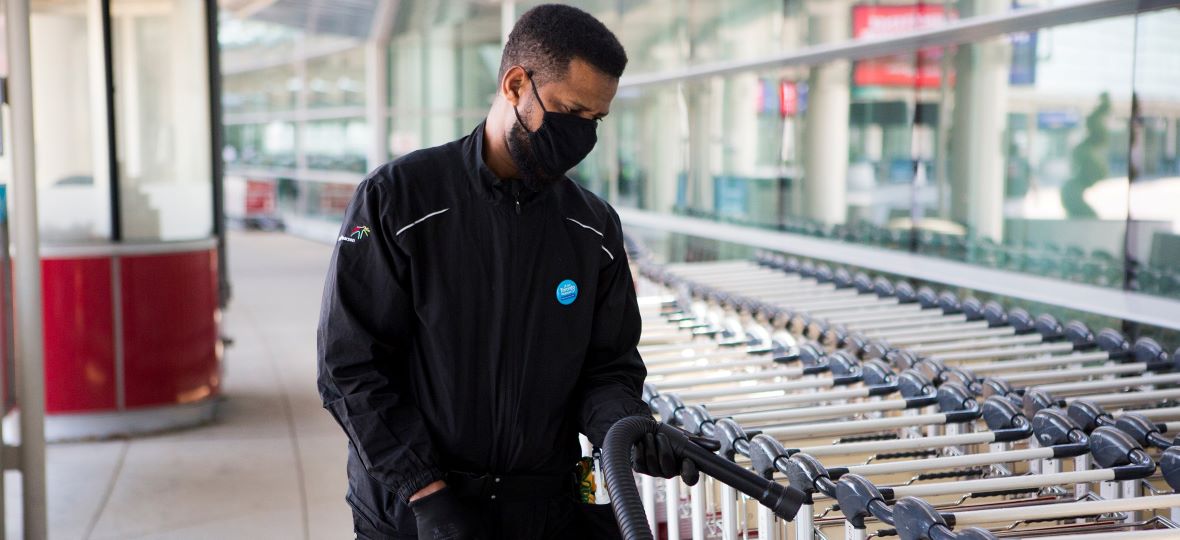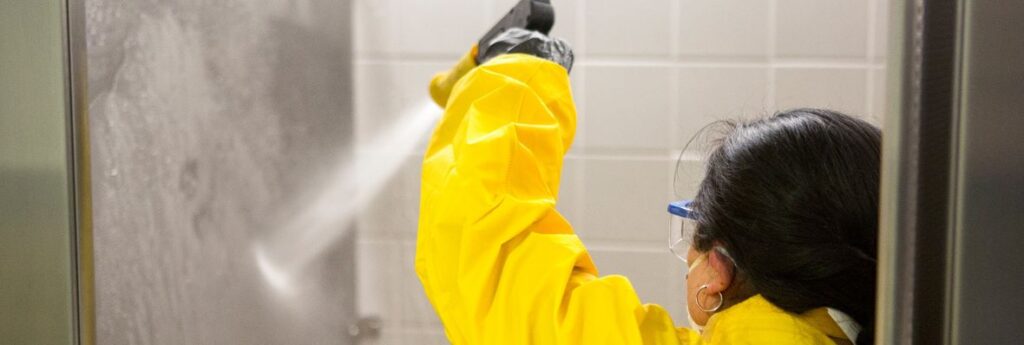As travel begins to slowly take flight, Canadian airports are grounding themselves in new health and safety protocols ahead of an anticipated increase in airline activity in July, but also in recognition of “the new realities of air travel” prompted by COVID-19 and “advancing the future of healthy travel corridors.”
From automated cleaning units to reserved appointments for security clearance, here’s a look at what’s in store, and in some cases, already happening, at four major Canadian facilities as they contend with, and look beyond, the coronavirus pandemic:
TORONTO
The nation’s busiest airport, serving more than 50 million passengers in 2019, Toronto Pearson launched its “Healthy Airport” commitment early this week, a comprehensive program that includes a strategic partnership with BlueDot, a leader in advanced data analytics and technologies to predict and monitor infectious disease risks.
The Greater Toronto Airports Authority (GTAA) says the measures are aligned with ICAO and IATA protocols and Transport Canada’s framework for addressing COVID-19 and the recovery of the aviation sector.
“As government restrictions on air travel begin to be lifted and flights increase, Toronto Pearson is ready, and we are intent on exceeding international standards,” says GTAA president and CEO Deborah Flint.
That includes a five-point commitment, to:
• The highest standards for cleaning and hygiene
• Clear communications and the introduction of innovative technology advancements, including touchless check-in
• A disinfection corridor for airport workers
• Facility monitoring for congestion, and,
• Autonomous floor cleaning machines and air quality monitors.
GTAA had already introduced the following measures on June 1, dedicated to “making passenger and employee health our top priority”:
• Mandatory masks
• Limited access to airport facilities
• Continued enhanced cleaning and hygiene, and
• Increased signage for physical distancing
Many of the 400-plus organizations operating out of YYZ – including air carriers and transit agencies – are also implementing health and cleaning measures and conducting workforce education, says the GTAA, which says it working on a pilot of wearable tracing and physical distancing technology for airport workers.

MONTREAL
ADM Aéroports de Montréal says it has been working closely with federal and provincial public health agencies to ensure that Montréal-Trudeau International Airport provides a healthy and safe environment for all its users as it prepares for a greater influx of passengers as borders begin to re-open. The following additional measures are being implemented at various strategic points along the terminal’s route as part of YUL’s new “Travel with Confidence” program:
Upon arrival
• Only entrances 4, 11 (departures level) and 25 (arrivals level) will provide access to the terminal. These will be equipped with their own health checkpoint where passengers will be required to wear a mask, wash their hands, have a temperature reading taken, and answer health-related questions
• Only travellers and employees will be allowed to enter the terminal building. Accompanying persons must remain in their car in the drop-off zone unless they are escorting a person requiring special attention or a minor child. However, they will be subject to the same health checks as passengers
• A number of features on yul.com will allow passengers to book their services, including reserving parking spaces and reservation of passage through the security checkpoint for departures of international and domestic flights
In the terminal
• Face coverings will be mandatory, except for children under two and persons with breathing difficulties, disabilities or unable to remove their mask without the assistance of a third party
• Areas where passengers are travelling will be cleaned and disinfected 10 times a day
• Disinfectant gel dispensers will be accessible in the terminal building at each stage of the passenger journey where there will be contact or a need to handle the mask
• Washroom sinks, soap dispensers and hand dryers are automated
• Baggage carts will be disinfected and cleaned after every use
• Restaurants and shops will ensure that all current health regulations are followed, including reduced seats to allow for physical distancing
On leaving
• Only essential assistants or helpers will be permitted to enter the terminal to greet travellers.
• Taxi drivers licensed to operate at YUL will be required to clean their car between each customer, wear a mask, and wash their hands regularly. Some vehicles will be equipped with a plexiglass screen separating the front seats from the passenger seats. Passengers can make a request to the dispatcher to use one of these vehicles.
In the coming months, the use of new technologies will increase the automation of other processes, further limiting points of contact.
VANCOUVER
YVR TAKEcare, Vancouver International Airport’s new multi-layered health and safety program, is designed to “create a safe and frictionless airport experience – from the curb to the cloud – so that passengers and employees feel confident while at the airport,” says Robyn McVicker, VP, Operations & Maintenance at the Vancouver Airport Authority.
As part of the program, YVR is streamlining airport processes to ensure a seamless, touchless and physically distanced travel experience by investing in new technologies and reconfiguring airport infrastructure. YVR is expanding on existing measures as well as implementing new ones. Current TAKEcare measures include:
• Asking that face coverings be worn at all times while in the public areas of the terminal
• Requesting that only travellers with a valid ticket and employees who work at YVR enter the terminal building, with exceptions made for those requiring extra assistance
• Increasing cleaning across all high-touch areas
• Providing additional hand sanitizer throughout the airport
• Installing plexiglass at counters to provide guests and employees with an additional layer of prevention
• Placing TAKEcare team members at key locations throughout the terminal to provide assistance and answer any questions
• Displaying clear in-terminal signage throughout the passenger journey that encourages physical distancing whenever possible
• Facilitating temperature screening at the entrance of security screening for some travellers. This process will become standardized in the coming days for all passengers, as announced recently by Transport Canada.
The program will continue to evolve in the weeks ahead following any additional guidance and directives from government, health authorities and industry experts.
CALGARY
The Calgary Airport Authority is bolstering already enhanced cleaning protocols and physical distancing guidance at YYC by introducing the mandatory requirement for all staff, passengers and essential visitors to wear a mask/face covering while in any public area of the domestic or international terminals. The new requirement is in addition to Transport Canada’s existing requirements to wear masks at screening checkpoints and during flight when they cannot physically distance from others.
Other #FlyHealthyYYC measures include:
• Physical distancing decals and signage to reinforce people stay two metres apart if possible
• Additional cleaning for high-touch areas such as kiosks, check-in/boarding gates, handrails, seating, washrooms, baggage carts, escalators and moving sidewalks
• More hand sanitizer stations in high traffic locations
• Support for government regulations such as Transport Canada’s airport temperature screening
• All staff, guests or essential visitors should come with their own mask/face covering (or buy them on site)
• Staff, guests and visitors should only enter the building if necessary for travel or imminent work
More information is available, including exception criteria, on the airport web site.

